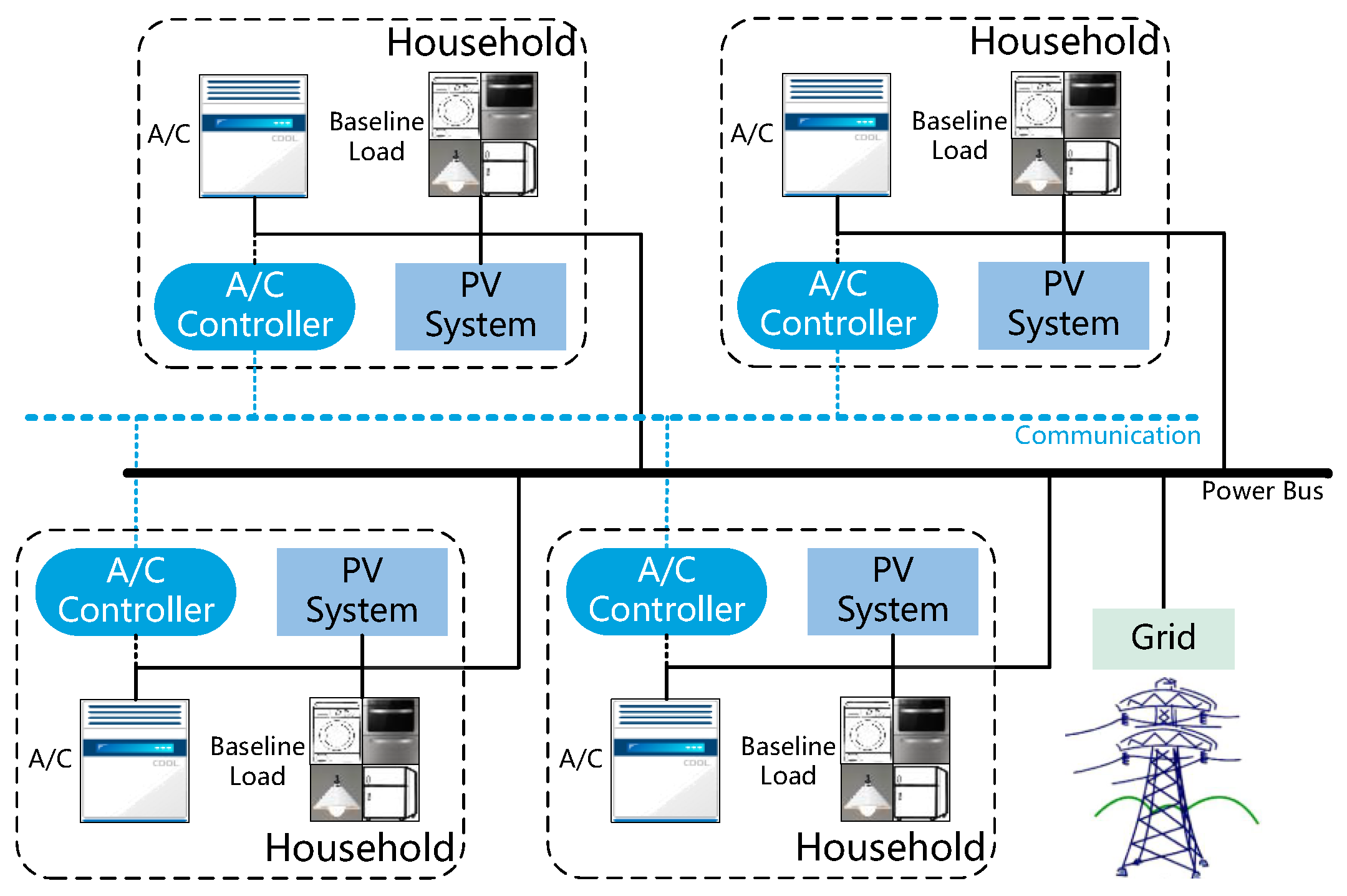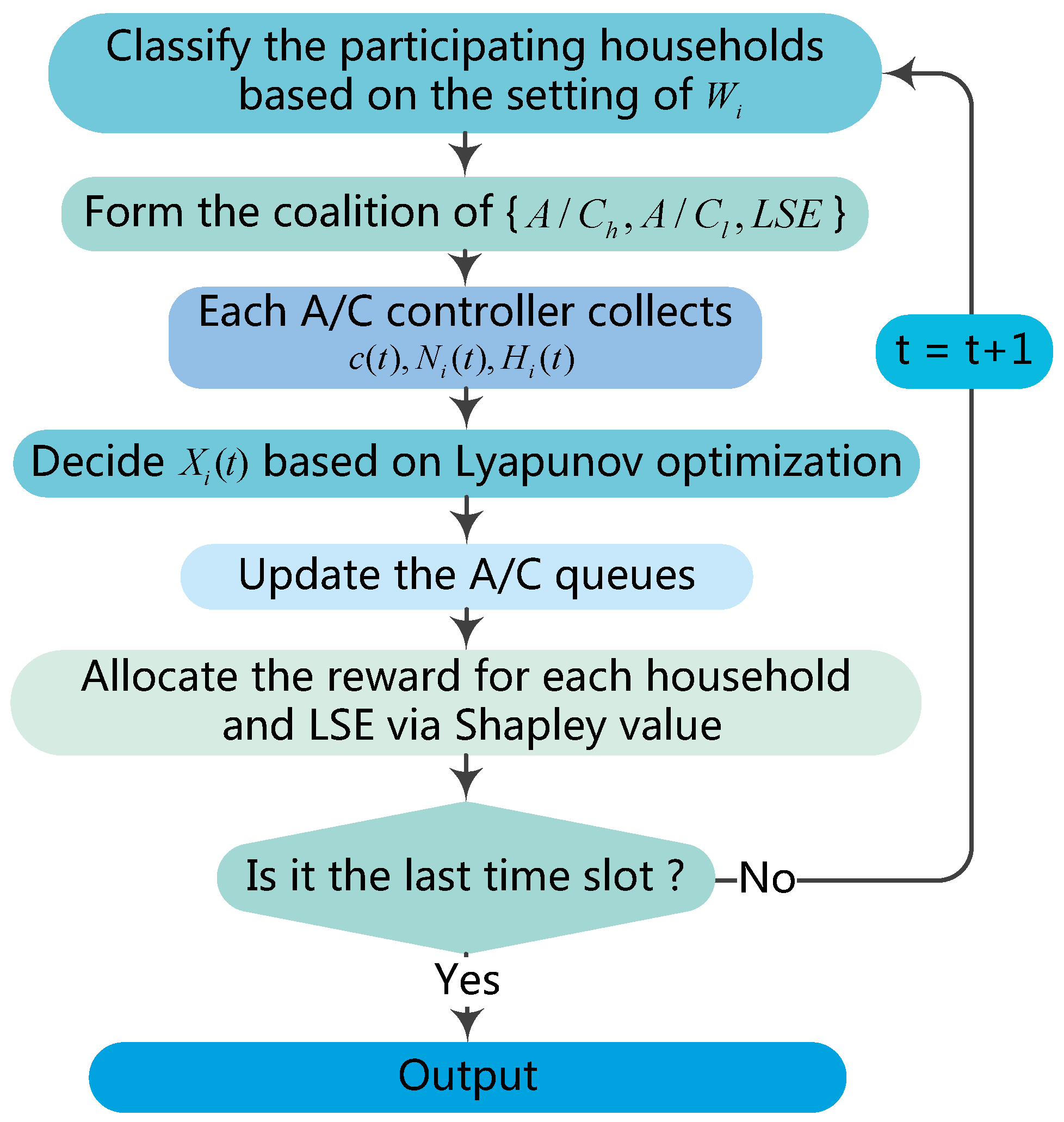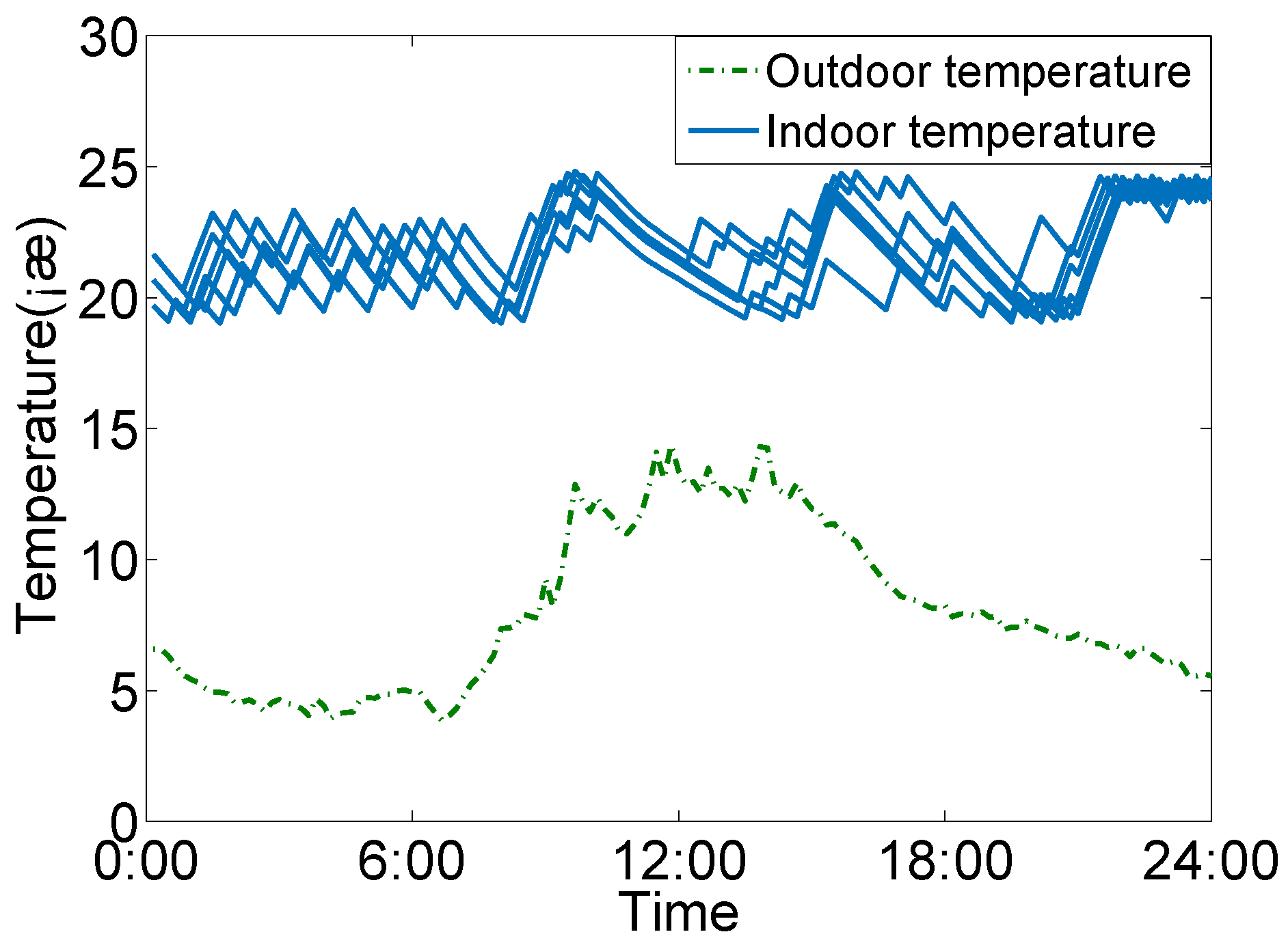1. Introduction
With more electricity-consuming products coming into our daily lives, such as electrical vehicles and air conditioning (A/C) systems, load demand increases dramatically and imposes significant burdens on the existing power grid [
1,
2]. Along with developments in smart grid technologies—such as two-way communication networks and advanced metering infrastructure [
3,
4]—the control and monitoring of end use loads at the appliance level in smart households is realized [
5,
6]. The new information and communication technology infrastructures allow faster and more efficient communications, which offers numerous technical benefits and flexibilities and makes cooperation between utility providers and consumers possible [
7,
8].
The end users are indeed becoming aware of taking part in the sustainable operation of the energy system within an overall smart community strategy [
9,
10], rationalizing the amount of energy required by controllable loads [
11], or by wisely scheduling run times of smart appliances that are likely to be shifted in time [
12,
13], and also turning themselves into potential carbon-free generators of energy, through the use of renewable resources [
14,
15]. Among the smart appliances in households, A/C has traditionally drawn more attention than other end use loads because of its ability to shift energy consumption within a certain time period by storing electricity as thermal energy [
16,
17]. On the other hand, A/C is one of the major consumers of energy and has a significant influence on the overall energy usage of households. Controlling the energy consumption of A/C can lead to significant energy savings for smart households [
18]. The potential of A/C units for load balancing/regulation service has been evaluated in [
19]. However, the load control of A/Cs adversely impacts the thermal comfort of customers. Reducing the discomfort of consumers is a top priority in the energy management of A/C units. To this end, studying the energy consumption behavior of A/C units and developing algorithms for effective control without compromising users’ comfort have become an important part of energy management research [
20].
In the last few years, some studies have been devoted to the intelligent and interactive management of A/C units. Some papers need to be based on the forecast value of system variables to solve the optimization issues for A/C energy management. For example, [
21] developed an innovative event-based approach to minimize the A/C’s day-ahead energy cost, which is based on the forecast information of the system. In [
22], a novel intelligent residential A/C system controller is set forth to provide optimal comfort/cost trade-offs for the residents. However, the controller needs to use weather forecast information. Hong et al. [
23] aimed to obtain the optimal temperature scheduling for A/Cs according to the day-ahead electricity prices and the forecasted outdoor temperature. In the load control strategy of [
24] A/C temperatures were set according to the forecasted prices and outdoor temperatures 24 h in advance. Meanwhile, some other papers formulate the A/C control problem as an optimization problem with complex constraints and need to analyze a large number of historical data or adopt complex traditional algorithms, including model predictive control [
25], genetic algorithms [
26], and dynamic programming [
27], which is of high computational complexity. For instance, a centralized optimal control algorithm with comfortable room temperature consideration is proposed in [
28] by controlling the operational set-point of A/C units. However, the control algorithm relies on the population information of the room temperature, which makes it vulnerable to implementation online. Sun et al. [
29] developed a methodology which combines stochastic programming and rollout techniques for controlling A/Cs in order to minimize the electricity cost. In [
30], a mixed integer multi-scale stochastic optimization problem was formulated, and an algorithm based on model predictive control was proposed for the scheduling A/Cs for a home energy management system.
From the above, the existing studies on A/C energy management have fully reflected the potential ability of A/C units on the demand side. However, most of them are based on forecasting models or complex computation, which is not suitable for practical application. As for the forecasting model, due to the time-dependent uncertainties in weather condition, the unpredictable behavior of customers, and the intermittent nature of renewable energy resources [
31], the forecasting error of these sources of information is relatively large [
32], making the energy management of A/C much more challenging. On the other hand, the contribution of A/C in the demand response is not quantified in these researches. The householders cannot get the corresponding reward, which is disadvantageous for the long-term cooperation between householders and the load serving entity (LSE). In brief, there is a need for a cooperative strategy with a fair reward allocation scheme and a control algorithm for A/C units with low computational complexity. In this paper, motivated by A/C units’ potential in demand response, a coalitional game for a smart community and an online energy management algorithm for A/C units are proposed. In the algorithm, we tackle the A/C energy management problem with a Lyapunov optimization approach [
33], which is a useful technique for solving stochastic network optimization and does not rely on any future information.
The main contributions of this paper are summarized as follows:
A coalitional game framework is established between smart households and the LSE to improve the revenue of the community. The LSE sells renewable energy to the householders and provides energy saving service for A/C units in the household through an A/C controller. A suitable utility function is proposed to capture the benefit to the coalition. The game is economically beneficial to both the households and the LSE, with the improvement of the self-consumption for renewable energy.
In the A/C controller provided by the LSE, an online energy management algorithm based on Lyapunov optimization is developed for A/C units to reduce the amount of electricity purchased from the main grid and further increase the revenue of the coalition. It does not rely on any future information, and could quickly make decisions under the fluctuation of weather conditions, renewable generation, load demands, and prices. The decision at each slot can be made by only using the current observations, which has high efficiency and requires small computational resources.
The Shapley value is adopted to allocate the reward of each member in the coalition, which provides a fair and unique solution for the coalitional game. The contribution of each participating householder is quantified, which is beneficial for the long-term operation of the coalition. The simulation result verifies that a householder with a greater contribution would get more benefits.
The rest of this paper is organized as follows. In
Section 2, we begin with the introduction of the system model and the description of the operation mode of the smart community considered in this study. To improve the revenue of the smart community, we propose a coalitional game and the corresponding reward allocation scheme for the participating households and LSE in
Section 3. In the A/C controller of each participating household—which is provided by LSE in the game—we develop an online algorithm for A/C to solve the cost minimization problem of each household in
Section 4. Simulation results based on real-world data are presented and analysed in
Section 5. Finally, some concluding remarks are presented in
Section 6.
3. Coalitional Game for the Smart Community
Coalitional game is a branch of game theory that studies whether a group of players—i.e., the households and the LSE in this paper—can be better off if they decide to join in a coalition [
36]. A coalitional game is defined by
, where
is the set of participating players and
is a function that assigns every coalition
a real number which represents the rewards achieved by
.
3.1. Proposed Coalitional Game
In this paper, the smart households and LSE in
form a coalition
. The reward that the coalition of
can obtain is the increased profit under the coalitional game compared with that of the independent mode, under which the participating households do not cooperate with each other and operate independently. The value function
for the coalition
can be defined as:
where
is the total cost of all players when they do not cooperate with each other.
is the overall cost of the coalition under the coalitional game. Since Equation (
3) represents the revenue of the coalition
, it can be divided in any arbitrary manner between the members. Therefore, the proposed coalitional game
is a game with transferrable utility [
37].
Theorem 1. Consider as the set of N households in the community where the LSE provides PV panels for every householder. The reward will increase for the households as more of them agree to form a coalition with the LSE.
Proof. Given the fact that the feed-in-tariff of PV power is lower than the purchasing price from the main grid, the self-consumption of PV power would be beneficial for both the households and the LSE. As more households from form a coalition with the LSE to consume the PV power, the electricity purchased from the main grid will reduce, and at the same time, the expected rewards of the coalition will increase. Additionally, the participating householders will get certain rewards according to their contribution to the coalition. Therefore, it would always be beneficial for each household to join the coalition in order to reap greater payments. ☐
According to Theorem 1, the proposed coalitional game will manifest itself in increased profit that can be shared among the participating households and the LSE in the coalition.
3.2. Reward Allocation Scheme
It has been demonstrated in Theorem 1 that the proposed coalition could result in increased profits for the whole group of players. In this section, we will clearly show how the cultivated rewards from the coalition should be shared among the participating players. The Shapley value is adopted to allocate the increased profits among the participating players.
The Shapley value is a solution concept that provides a unique expected payoff allocation for a given coalitional game (
). It describes an effective approach to the fair allocation of gains obtained by cooperation among the players of a coalitional game. The concept of the Shapley value (which was developed axiomatically by Shapley [
38]) considers the relative importance of each player to the game in deciding the payoff to be allocated to the players.
denotes the payoff to each player
. Fairness is defined as satisfying the following four axioms, which a payoff allocation scheme would reasonably be expected to satisfy.
(1) (Efficiency) The entire payoff is divided among the participating players without excess remains, which can be described as .
(2) (Symmetry) Two participants that contribute equally are rewarded equally. Let , if then .
(3) (Null player) Participants that do not contribute receive no payoff. Let , if then .
(4) (Linearity) The total payoff rewarded for contributing to two games is the sum of the payoffs that would be awarded for contributing to each of the two games individually. If and are two value functions then .
The Shapley value can be shown to be the only payment distribution method that satisfies these four axioms, with the added benefit that the solution is unique. Mathematically, the Shapley value
of a player
i is given by:
The Shapley value
can be interpreted as the expected marginal contribution that player
i makes to any coalition of
, assuming all orderings are equally likely. Thus, the Shapley value takes into account all possible coalitional dynamics and negotiation scenarios among the players and comes up with a single unique way of distributing the value
of the grand coalition among all the players [
39]. In this paper, we adopt the Shapley value as the reward allocation technique for the participating householders and the LSE.
6. Conclusions
This paper has proposed a theoretical coalitional game approach for the cooperation between households and LSE in a smart community. In the coalitional game, householders can be considerably rewarded and acquire energy saving service from the A/C controller by purchasing PV energy from the LSE. Moreover, in the A/C controller that the LSE provides for the participating householders, an online energy management algorithm based on Lyapunov optimization is developed for the control of A/C units to reduce the amount of electricity purchased from the main grid and further increase the revenue of the coalition. This algorithm transfers the original A/C energy management problem into a linear programming problem, which effectively reduces the computational complexity. The Shapley value has been adopted to divide the reward of the coalition among the participating members, based on their contribution. Through simulation with realistic data from the residential community, we have shown that the proposed coalitional game and A/C energy management algorithm can effectively increase the profits of householders and the LSE compared to the noncooperative case.
Our results demonstrate that the proposed coalitional game has significant potential to serve as an effective means of improving the profitability of the LSE and cutting the expenses of householders. As for practical application, the operation mode based on the proposed coalitional game can be used to help community planners to improve the total revenue. Particularly, the time complexity of the proposed algorithm is low and the required computational resource is small, which makes the algorithm suitable to be integrated into the embedded system in smart households. Moreover, the algorithm can be implemented in a distributed way, which has fewer communication costs. The A/C controller based on the proposed algorithm can be used to determine the least-cost schedules of A/C while guaranteeing householders’ comfortable experiences. When setting the weight parameters in the A/C controller, householders are able to choose a larger value in order to get more payments.












